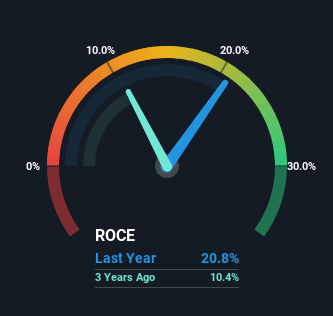- United States
- /
- Interactive Media and Services
- /
- NYSE:SSTK
Investors Should Be Encouraged By Shutterstock's (NYSE:SSTK) Returns On Capital

To find a multi-bagger stock, what are the underlying trends we should look for in a business? Firstly, we'll want to see a proven return on capital employed (ROCE) that is increasing, and secondly, an expanding base of capital employed. Put simply, these types of businesses are compounding machines, meaning they are continually reinvesting their earnings at ever-higher rates of return. With that in mind, the ROCE of Shutterstock (NYSE:SSTK) looks great, so lets see what the trend can tell us.
Understanding Return On Capital Employed (ROCE)
For those that aren't sure what ROCE is, it measures the amount of pre-tax profits a company can generate from the capital employed in its business. Analysts use this formula to calculate it for Shutterstock:
Return on Capital Employed = Earnings Before Interest and Tax (EBIT) ÷ (Total Assets - Current Liabilities)
0.21 = US$124m ÷ (US$1.0b - US$408m) (Based on the trailing twelve months to June 2023).
Therefore, Shutterstock has an ROCE of 21%. In absolute terms that's a great return and it's even better than the Interactive Media and Services industry average of 7.0%.
Check out our latest analysis for Shutterstock

In the above chart we have measured Shutterstock's prior ROCE against its prior performance, but the future is arguably more important. If you're interested, you can view the analysts predictions in our free report on analyst forecasts for the company.
So How Is Shutterstock's ROCE Trending?
The trends we've noticed at Shutterstock are quite reassuring. Over the last five years, returns on capital employed have risen substantially to 21%. The company is effectively making more money per dollar of capital used, and it's worth noting that the amount of capital has increased too, by 58%. The increasing returns on a growing amount of capital is common amongst multi-baggers and that's why we're impressed.
On a side note, Shutterstock's current liabilities are still rather high at 41% of total assets. This effectively means that suppliers (or short-term creditors) are funding a large portion of the business, so just be aware that this can introduce some elements of risk. Ideally we'd like to see this reduce as that would mean fewer obligations bearing risks.
The Bottom Line On Shutterstock's ROCE
A company that is growing its returns on capital and can consistently reinvest in itself is a highly sought after trait, and that's what Shutterstock has. Given the stock has declined 21% in the last five years, this could be a good investment if the valuation and other metrics are also appealing. So researching this company further and determining whether or not these trends will continue seems justified.
On a separate note, we've found 1 warning sign for Shutterstock you'll probably want to know about.
High returns are a key ingredient to strong performance, so check out our free list ofstocks earning high returns on equity with solid balance sheets.
New: Manage All Your Stock Portfolios in One Place
We've created the ultimate portfolio companion for stock investors, and it's free.
• Connect an unlimited number of Portfolios and see your total in one currency
• Be alerted to new Warning Signs or Risks via email or mobile
• Track the Fair Value of your stocks
Have feedback on this article? Concerned about the content? Get in touch with us directly. Alternatively, email editorial-team (at) simplywallst.com.
This article by Simply Wall St is general in nature. We provide commentary based on historical data and analyst forecasts only using an unbiased methodology and our articles are not intended to be financial advice. It does not constitute a recommendation to buy or sell any stock, and does not take account of your objectives, or your financial situation. We aim to bring you long-term focused analysis driven by fundamental data. Note that our analysis may not factor in the latest price-sensitive company announcements or qualitative material. Simply Wall St has no position in any stocks mentioned.
About NYSE:SSTK
Shutterstock
Provides platform to connect brands and businesses to high quality content in North America, Europe, and internationally.
Reasonable growth potential with adequate balance sheet.
Similar Companies
Market Insights
Community Narratives



